Anemonefish
Anemonefish can be found in Australia's famous Great Barrier Reef. Although predators of the Anemonefish get stung by the Anemone, the Anemonefish can live quite happily next to the Anemone.
Archerfish (Toxotes chatareus)
Archerfish are small silver fish, which live in the waters of the mangroves. The Archerfish hunts for food under the water, although due to its binocular vision can also shoot water at insects on plantlife above the water.
Australian Fur Seal (Arctocephalus pusillus doriferus)
Australian Fur Seals live along the southern coastline of Australia, and due to the fact that they have ears belong to the Otariidae family. The males grow to a large 2 metres, while the females tend to only grow to about 1.5 metres long.
Australian Sea Lion (Neophoca cinerea)
Australian Sea Lions are only found along the Southern and south western coastline of Australia. A large proportion of Australian Sea Lions breed within the Great Australian Bight.
Barramundi (Lates calcarifer)
Barramundi live in the rivers of Far North Australia, and are part of a large fishing industry in Australia. Barramundi are able to live in salt water, and head to the sea to spawn. When the fingerlings are born they are male, although after about 4 years they turn into females.
Blue Spotted Ray (Taeniura lymma)
The Blue Spotted Ray is rarely seen, although can be found in the waters of Far North Queensland and within the Great Barrier Reef. They often hide in caves or within sandy banks where they feed upon molluscs.
Blue Tang (Paracanthurus hepatus)
Blue Tangs are a glorious electric blue colour, with a bright yellow tail. Blue Tangs can be found around the Great Barrier Reef, and belong to the Surgeon Fish family due to their venomous tang at the base of their tail fin.
Bream (Acanthopagrus australis / Acanthopagrus butcheri)
Around the coastline of Australia are three different types of Bream, all belonging to the Sparidae family. Along Australia's east coast are both the Black and Silver Bream, whereas along the southern coast is the Blue-Nosed Bream. Bream are often sort after for food, and a popular choice for fishermen.
Crown of Thorns Starfish (Acanthaster planci)
The Crown of Thorns Starfish is a very unusual looking starfish. It has many thorny arms, and a large bulging body full of thorns. The Crown of Thorns Starfish eats Coral Polyps and so can cause damage to the Coral Reef.
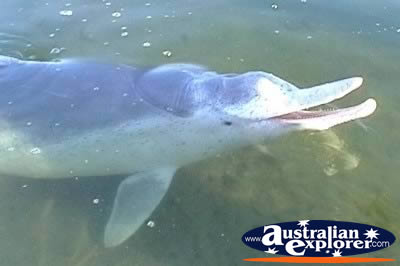 Dolphins
Dolphins
Dolphins are marvelous creatures which can be found in the waters surrounding Australia. There are several different types of dolphin which you may come across, with the most common being the Bottlenose Dolphin.
Dugong (Dugong dugon)
Dugong are also called 'Sea Cows' and are large herbivorous mammals. They live in the tropical northern waters of Australia, and feed on the various algae and sea grasses.
Eagle Ray (Aetobatus narinari)
The Eagle Ray is one of the most attractive Rays, with its shiny blue/black coat covered in white/grey spots. The Eagle Ray has a long tail, which has about 3 barbed spines, and its teeth are actually plates, which it uses to crush its food. Eagle rays eat molluses near the bottom of the ocean, although can quickly dive out of the water to escape from dangerous predators.
Fairy Penguin
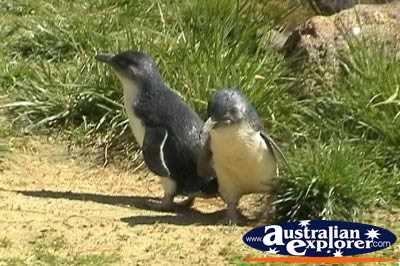 Fairy Penguins are the only type of penguin to breed in Australia, and matching their name they are also the smallest of all the 18 different species of penguin. Most of the Fairy Penguins are found along the southern coastline of Australia, catching anchovies, pilchards and squid as food
Fairy Penguins are the only type of penguin to breed in Australia, and matching their name they are also the smallest of all the 18 different species of penguin. Most of the Fairy Penguins are found along the southern coastline of Australia, catching anchovies, pilchards and squid as food
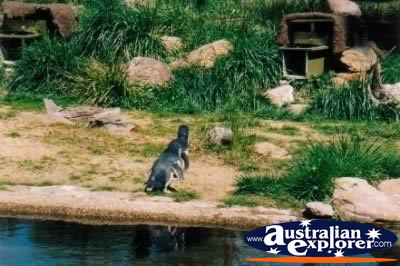 Fairy Penguin cannot fly and so stay in the water for most of the time. Their dense feathers insulate them from the cold water as well as a waterproof oil which they produce and spread over themselves, and their eyes have excellent sight in and out of the water. When Fairy Penguins are moulting they cannot go in the water, and so overfeed before this happens and fast during this time.
Fairy Penguin cannot fly and so stay in the water for most of the time. Their dense feathers insulate them from the cold water as well as a waterproof oil which they produce and spread over themselves, and their eyes have excellent sight in and out of the water. When Fairy Penguins are moulting they cannot go in the water, and so overfeed before this happens and fast during this time.
Fairy Penguins can travel long distances away from its colony, although always return to breed. Breeding occurs during September, with an average of two eggs laid. Both parents incubate the eggs, and once they hatch are looked after for two weeks by one parent while the other gets food, and then left alone for the next 6 weeks while both parents get food. Once they reach about 8 weeks old, they are able to go off on their own. Due to the fact that the Fairy penguins live on land and in the sea they have double the amount of predators, and the chicks are especially vulnerable between 2-8 weeks old.
Fiddler Ray (Trygonorrhina fasciata)
The Fiddler Ray is pale brown in colour, with a covering of unique leopard like white spots. The Fiddler Ray mainly stays along sandy banks, feeding on various sea crustaceans.
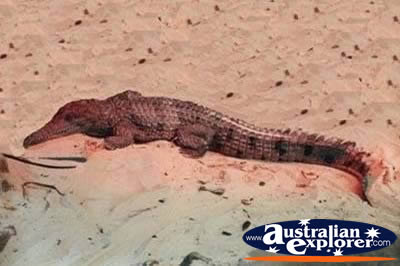 Freshwater Crocodile (Crocodylus johnstoni)
Freshwater Crocodile (Crocodylus johnstoni)
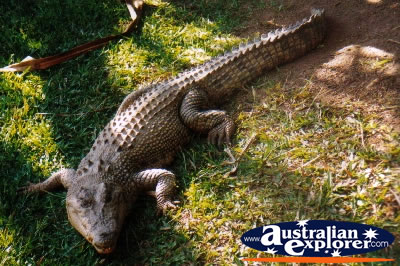 Freshwater Crocodiles live in the northern inland rivers of Australia adapting well to the changing tropical weather. They can grow to a length of about 2.5 metres and have a slim body and snout. Unlike Saltwater Crocodiles they don't generally attack humans, although have bitten people.
Freshwater Crocodiles live in the northern inland rivers of Australia adapting well to the changing tropical weather. They can grow to a length of about 2.5 metres and have a slim body and snout. Unlike Saltwater Crocodiles they don't generally attack humans, although have bitten people.
The breeding time for Freshwater Crocodiles is around August - September. Their eggs stay buried in the sand until November - December when they hatch.
Giant Tasmanian Crabs
The Giant Tasmanian Crabs are to no surprise the largest crab found around Australia, and one of the largest crabs found in the whole world. They live deep in the southern oceans of Australia, and can grow to around 40cm across, weighing about 15kg.
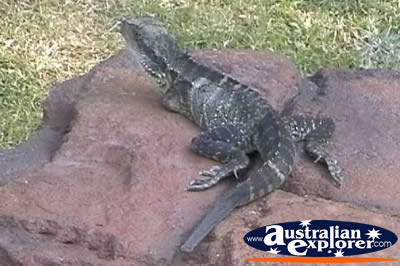 Gippsland Water Dragons (Physignathus lesueurii howittii)
Gippsland Water Dragons (Physignathus lesueurii howittii)
The Gippsland Water Dragon is a reptile found alongside riverbanks. They have effective camouflage and so are difficult to spot. They can also stay under the water for around 90 minutes.
Grey Nurse Shark (Carcharius taurus)
The Grey Nurse Shark is one of the sharks that has been listed as protected, although many still get killed accidentally by amateur fishermen. Grey Nurse Sharks don't normally attack humans, and only do so if provoked. Grey Nurse Sharks give birth to live young, which generally consists of two pups at a time.
Hermit Crabs
Hermit Crabs can be found amongst muddy and rocky shorelines around Australia. They have extremely delicate abdomens, and so live in sea snail shells to protect it. Hermit Crabs twist into the shells and continue to grow, and so have to keep finding new shells in which they can live.
Humpback Whale (Megaptera novaeangliae)
Humpback Whales live in the cooler southern polar seas, although can often be seen along the east and west coasts of Australia during their migration. In the winter they migrate to the sub-tropical waters to breed, and then return to the cooler waters several months later. Humpback Whales generally live for about 30 years, and can grow to about 20 metres long.
Leopard Shark (Stegastoma fasciatum)
Leopard Sharks are generally not dangerous and have a very distinctive skin pattern, of with brown spots covering its sandy coloured body. The young hatch from eggs laid by the Leopard Shark, and are actually called Zebra Sharks due to their Zebra (and not Leopard) pattern.
Long-Snouted Butterfly Fish (Forcipiger longirostris)
The Long-Snouted Butterfly Fish have a magnificent white and yellow pattern to their bodies, with their eyes conveniently disguised by a black stripe. They can be found around Coral, and feed off of the invertebrates hiding between the pieces of Coral.
Lungfish (Neoceratodus forsteri)
The Lungfish has been around for the past 100 million years, and survives with the rivers of northern Australia. Lungfish are classed as living fossils, and so are a protected species. They can also cleverly survive during the dry season (when there is less oxygen in the water), by breathing in air from the surface of the water with only one lung.
Marine Turtles
You will find many different Marine Turtles, all of varying size within the Great Barrier Reef. The Great Barrier Reef is an excellent breeding ground for the turtles.
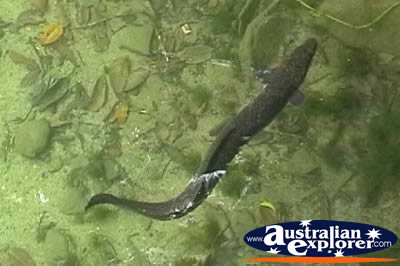 Moray Eels (Gymnothorox prasinus)
Moray Eels (Gymnothorox prasinus)
Moray Eels have thick skin with no scales and only a single dorsal fin along their back. They are found in warm waters surrounding Australia, and love hiding amongst rocks and in crevices. Night is when the Moray Eel feeds, and although they aren't too dangerous they have sharp teeth and do attack if provoked.
Mudskipper
Mudskippers live on the mud flats of within the Australian mangrove regions. It has small leg-like fins which allow it to walk across the mud, and can even stay out of the water by retaining water within its gills. The Mudskipper hunts for food under and above the water (which it can do at the same time due to its large, bulging eyes).
Murray Cod (Maccullochella peeli)
The Murray Cod is one of the largest freshwater fish in the whole world, and is the largest freshwater fish in Australia. Murray Cod have a speckled appearance and can be found mainly in deep holes surrounding by logs, rocks and vegetation. Spring is when the Murray Cod produce their eggs, which stick onto a fixed object and are watched by the male until they hatch.
Octopus
The Octopus is a very complex creature, with an unusual composition. They belong to the Cephalopod family, meaning 'head-foot' in Greek, which is exactly what they are. Octopuses live in the rocky waters around Australia's coastline, and can survive in the widely varying weather conditions. They can cleverly change colour to demonstrate different moods, as well as to blend into the background. In protection they can also squirt out a brown ink, so that they can escape from predators.
Old Wife (Enoplosus armatus)
Old Wife fish are found along the South Eastern coast of Australia, and have a beautiful silver and black stripped body. Although they look nice, they have sharp spines on the top of the head, as well as a poisonous spine on the dorsal fin.
Pig-Nosed Turtle (Carettochelys insculpta)
The Pig-Nosed Turtle lives in the far northern rivers of Australia, and survives mainly under water although leaves the water to lay its eggs. Its nose is aptly pig shaped, and unlike many other turtles it has a soft shell. Due to this soft covering, they are able to breathe a little oxygen in through their skin and so stay under water longer.
Platypus (Ornithorhynchus anatinus)
The Platypus is a mammal belonging to the Monotremes group, although unlike many other mammals is able to lay eggs. The Platypus has a beak and a body covered in fur. It lives in the Eastern rivers of Australia, and likes to bury into the deep river banks. When swimming under the water, the platypus shuts its ears, eyes and nose, and so uses its beak to find food. Although the Platypus generally hunts for food under the water, it will also take insects from above the water. The Platypus is a protected animal, and has always been classed as sacred by the Aboriginal people.
Port Jackson Shark (Heterodontus portusjacksoni)
Port Jackson Sharks are found in the southern waters around Australia, and is named after Port Jackson Harbour (better known as Sydney Harbour). The Port Jackson Shark has a rather unusual look, with a pointed body, a flat head and long bulging eyes. Although the Port Jackson Shark eats various shell fish, they can be dangerous due to the sharp spines on its dorsal fins. The breeding time for the sharks is during August - September, although the eggs take a staggering 7 moths before they hatch.
Potato Cod (Epinephelus tukula)
The Potato is an extremely large fish which can be found off of the coast of Queensland, around the Great Barrier Reef. They are white/grey with large black spots, and can't be missed due to their size. It is also a protected species.
Pufferfish
Pufferfish can be found all around Australia's coastline, mainly living amongst the shallow waters near the shore. As defence the Pufferfish 'puffs' its skin out, filling it with air or water. The Pufferfish can be deadly, as within its skin is the highly poisonous Tetrodototoxin.
Saltwater Crocodile (Crocodylus porosus)
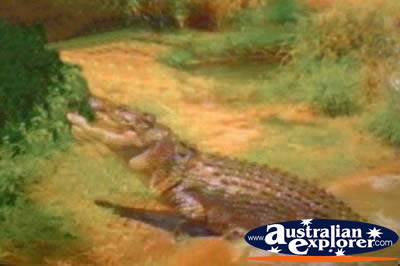 Saltwater Crocodiles live in the northern mangrove waters of Australia and have a wide frame and snout. They are the largest reptile predator in the world and generally bask along the riverbanks, although are always ready to attack.
Saltwater Crocodiles live in the northern mangrove waters of Australia and have a wide frame and snout. They are the largest reptile predator in the world and generally bask along the riverbanks, although are always ready to attack.
The Saltwater Crocodiles major sense organs include its ears, eyes and nose, which stay above the water whenever the crocodile is swimming. When swimming their tail propels them through the water (and also makes up half of the Saltwater Crocodiles entire length). They can also propel themselves 6ft in the air, out of the water, to catch their prey.
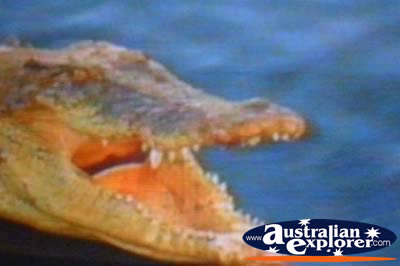 The Saltwater Crocodile has a mouthfall of very sharp teeth. Their 40 - 60 teeth grips their prey, and they then swallow their prey in chunks. However, because crocodiles have a slow metabolism they only need to eat about once a week.
The Saltwater Crocodile has a mouthfall of very sharp teeth. Their 40 - 60 teeth grips their prey, and they then swallow their prey in chunks. However, because crocodiles have a slow metabolism they only need to eat about once a week.
The breeding time for crocodiles is during the wet season, when the female lays around 60 eggs protected under the grass of the riverbanks. Depending on the heat that surrounds the eggs, the eggs may hatch as males (if hot) or females (if warm). If the eggs are kept too hot then the babies may be born with an abnormality. The baby crocodiles start at about 25cm long, although by the time they are about 8 years old can grow to a length of about 7 metres. Crocodiles have very long lives, and can survive for upto about 100 years.
Saratoga (Schleropages leichardti)
The Saratoga live in muddy holes at the bottom of Australia's northern rivers. To catch food, they quickly jump out of the water and grasp insects on the riverbanks. Once the Saratoga spawns, it carries the eggs in its mouth, and then protects the fish once they have hatched by calling them back into its mouth when danger is near.
Seahorse
Seahorses are found along the Southern and Eastern coasts of Australia, and the 35 species of Seahorse appear in all different colours. Seahorses are also fish, although have a very unique shaping and construction. Another unusual feature about Seahorses is that the eggs are placed inside of the males and they carry the young in its front. Seahorses are used a lot in Asian medicine, with numbers quickly reducing.
Seals
Many Seals can be found along the rocky shoreline of Australia's southern coast. They are warm blooded, marine mammals who live mainly in the water, although often bask on rocks. Seals are able to insulate their body well, by either their fatty blubber or their dual layer of fur. To cool themselves down, the Seals simply raise their flipper and the air passing over it cools the whole body down. Seals also have excellent vision, enabling them to see well under the water.
Sea Stars
Sea Stars can be found in many different rocky areas along Australia's coastline. There are many different colours and patterns on the Sea Stars, which are often very brightly coloured. On the underneath of Sea Stars are small sucker feet which the Sea Star uses to grip onto the rocks, as well as to open shells for feeding. There are various species of Sea Star all of different sizes, and with different numbers of arms. Sea Stars also have the fabulous ability of growing new body parts if they need them to help their survival.
Sea Urchins
Sea Urchins can often be found amongst the rocky shorelines of Australia, gripping onto the rocks with their small 'sucker' feet. From all sides of the Sea Urchin come sharp spines, which protect the Sea Urchin from predators. The Sea Urchin can move along the rock with the help of both its suckers and spines.
Sharks
In total there are around 375 different species of shark which all have varying characteristics. Many of these species are under threat to extinction due to being caught by fisherman, or trapped in fishermen's nets. Sharks can be found all around the coast of Australia, with the most dangerous staying in the cooler waters of the south. Although all sharks do receive the image of being dangerous, only around 5 of the total 375 are actually potentially dangerous to man. Most sharks feed on the weaker mammals in the sea, allowing the stronger ones to survive. When reproducing many sharks actually give birth to live young, although there are a few species that actually lay eggs.
Silver Batfish (Monodactylus argenteus)
Silver Batfish are found in the Southern and Eastern waters around Australia and like their name suggests have a glorious silver shine, with small yellow fins. Silver Batfish are very unusual in the fact that they shed their scales, known as 'Deciduous Scales'.
Smooth Freshwater Crayfish (Cherax destructor)
The Smooth Freshwater Crayfish is a crustacean, which grows by moulting its outer shell. To regrow a hard shell, it then eats the shell it has shed. It is bright blue in colour and is found in many Australian rivers.
Smooth Stingray (Dasyatis brevicaudata)
Smooth Stingrays are the largest of all Stingrays, and has an incredibly sharp and dangerous spine. The Smooth Stingray will often lift its spine over its body, and although will look aggressive is often just inquisitive.
Snake-Necked Turtles (Chelodina longicolis)
Snake-Necked Turtles can be found with Australia's river systems. Often when there is a drought the turtles will bury into the soil or mud at the bottom of a billabong.
Snapper (Chrysophrys auratus)
Snapper is very similar to Bream in that it is sought after by fishermen, lives in the southern and eastern waters along Australia's coastline and also looks very similar. The main identifying feature of the Snapper can be seen on the adults, who have a large lump on the top of their heads.
Southern Right Whale (Eubalaena australis)
Southern Right Whales live in the cooler southern waters of Australia, mainly around the Great Australian Bight. Southern Right Whales have a distinctive look, with their long baleen plates and down turned mouth. Luckily numbers have increased since whaling stopped.
Subantarctic Fur Seal (Arctocephalus tropicalis)
The Subantartic Fur Seal lives on the southern islands, off of the Australian coastline. They are smaller than the Australian Fur Seal, with a pale grey, short haired fur. The males grow to about 1.8 metres, with the females only growing to about 1.3 metres.
Trout Cod (Maccullochella mitchelli)
Trout Cod are very similar to Murray Cod, although vary in colour with a grey body and black spots. Trout Cod can be found in very few of Australia's river systems and are now a protected species.
Waratah Anemone (Actina tenebrosa)
The Waratah Anemone is bright pink, matching the New South Wales flower from which it was named. It is often found within rocky pools along the New South Wales coastline, and although looks like a sea plant is actually an animal. The Waratah Anemone's mouth is covered by many little tentacles, and along with feeding, the mouth is also used to produce new Anemones.
Whitetip Reef Shark (Triaenodon obesus)
Whitetip Reef Sharks can (to no surprise) be found around the Great Barrier Reef. They are generally not dangerous, and often hide away under Coral banks during the day. At night the Whitetip Reef Sharks comes out to feed upon various crustaceans and small fish.
Wobbegong
The Wobbegong can be aggressive at times, although is generally missed as it stays on the bottom of the ocean, and is often camouflaged against its background. There are three types of Wobbegong around Australia, all with different patterned bodies and a straggly fringe around their heads. (This fringe is what gives them the name as Carpet Sharks).



